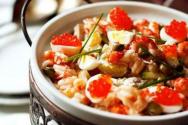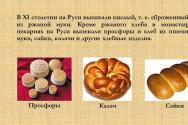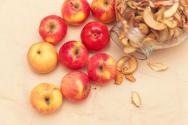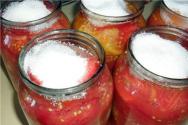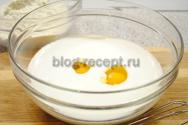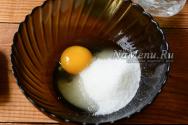Natural set for tinctures “French tincture. Traditional French liqueurs, liqueurs, liqueurs (recipes from French grandmothers) French liqueur at home recipe
Liquid honey
per 100 liters
5 kg honey
20 liters of warm water
125 g brewer's yeast
1 liter of white wine
Dilute honey with water, add yeast diluted in a glass of water and leave to ferment for 8 days, adding a glass of wine every day. When fermentation is complete, add water to 100 liters, tightly close the container with a lid and leave for 40-50 days. Strain and let stand for another month. Pour into bottles.
Tincture on ash leaves
per 100 liters
30 g ash leaves
20 g hops
125 g chicory
4 kg sugar
80 g tartaric acid
50 g brewer's yeast
Boil ash leaves, hops and chicory in 10 liters of water for 40 minutes, let cool. Add sugar and dissolve it completely. Add tartaric acid.
Dilute the yeast in a cup of water and let it ferment for 3-4 hours, then add it to the main mass. The total amount of liquid should be 100 liters.
Leave to ferment for 7-8 days. Strain and bottle.
Peach wine
for 1 bottle of good white wine
1/4 cup alcohol
20 peach leaves
15 lumps of sugar
Mix everything, pour in wine, leave for two days. Filter and bottle.
Sage wine
for 1 bottle of white wine
1 bunch of sage leaves (as much as will fit in your hand)
1/4 cup alcohol
honey
Pour wine over sage leaves for 12 hours. Add at least three tablespoons of honey and alcohol. Let stand for another 12 hours and filter. Pour into bottles. Khoroo as both an aperitif and a digestif.
Raspberry wine
for 1 bottle of red wine
500 g raspberries
1/4 cup alcohol
1 kg sugar
Pour wine over the raspberries and leave for 24 hours. Strain the liquid, pass the berries through a press, add sugar and heat over low heat for 15 minutes. Add alcohol to the hot solution. Filter and bottle.
Blackcurrant liqueur
3 liters of vodka
2 liters of good red wine
1 cup blackcurrant berries for every liter of liquid
Pour wine and vodka over the currants and leave for 3-4 months. Add sugar at the rate of 500 grams per liter of liquid, let it dissolve. Filter and bottle.
My reasoning: it seems to me that it is better to mash the currants a little before pouring the liquid, and add sugar at the end, heating it with the future liqueur so that it dissolves and let it sit, and then bottle it.
Elderberry liqueur
Place ripe elderberries tightly into a liter bottle and fill them with vodka. Place in the sun and leave for a month, then filter. Boil syrup from 125 grams of sugar and 500 ml of water and mix with the filtered liquid. Let it sit for another month.
Quince liqueur
1 kg quince
1 liter of alcohol (65 degrees)
250 g sugar
1 large glass of water
Cut the quince randomly, put it in a container and pour a glass of alcohol. Leave for 6 weeks. Finally, pour off the alcohol. Boil syrup from sugar and water, add drained alcohol to it. Pour into bottles.
Cook confiture, jelly or marshmallow from the remaining quince.
Nut wine
3 bottles of red wine, 13 walnuts without shells, a liter of grape alcohol, a kilogram of sugar. Mix everything and let it brew for 2 months.
Serve as an aperitif.
Chicory aperitif
Pour 4 teaspoons of chicory into a liter of light white wine, add the zest of two lemons and leave for 48 hours. Then filter, add alcohol (60 degrees) and bottle.
A very invigorating aperitif.
Sloe berry aperitif
Pour the sloe berries (as much as your hand can take) with a mixture of a liter of red wine and a glass of wine alcohol and leave for 48 hours. Then add syrup from 25 pieces of sugar dissolved in a small amount of hot wine.
Strain and bottle.
Traditional cherry liqueur
Squeeze juice from 1 kg of cherries and 250 grams of strawberries. Mix the juice with a liter of vodka, 180 grams of sugar, 2 grams of cinnamon and 4 clove buds. Leave for 24 hours, filter. Serve in a glass three-quarters filled with chopped cherries.
My notes: I would just put the cherries in bottles and fill them with that liquid.
Abricotine
Blanch 500 grams of pitted apricots in 500 ml of boiling water, peel them, pour the pulp with 500 ml of alcohol (90 degrees) and put in the refrigerator for 15 days.
Filter and mix with 500 ml white wine and 2.5 kg sugar. Pour into bottles.
My notes: I think it will be more convenient to dissolve the sugar in the wine by heating them a little, but not bringing them to a boil.
Prune liqueur
1 kg prunes
1 liter of white wine
1 glass of rum
32 lumps of sugar
Mix everything until the sugar is completely dissolved and leave for 24 hours. Pour into bottles.
Apricot kernel liqueur
100 pcs apricot kernels
1 liter of 40 degree alcohol (vodka)
600 g sugar (preferably brown)
100 ml cognac
Do not wash the apricot pits and try to save any pulp that sticks to them.
Place in a hermetically sealed container, add sugar and alcohol (vodka), seal well and leave for 3-4 months, in the sun if possible.
After the specified time, filter, add cognac, bottle and age for another 4 months.
"Little Oak"
Place 1 glass of leaves of a young oak tree in a hermetically sealed container and pour in a glass of grape alcohol, seal tightly and leave for 4-5 days.
Drain the liquid. Place the leaves in a saucepan, add water and bring to a boil. Add sugar at the rate of 30 pieces for every liter of liquid. Cool.
Dilute the syrup and drained alcohol.
Dilute with wine at the rate of: 1 glass of tincture per liter of wine.
There will be more recipes.
French tincture
Prepare a mixture of herbs taken in equal parts. Pour the herbal mixture into a bottle, add vodka and leave in a dark place for at least a month. Then strain, seal tightly and store.
Ingredients: vodka – 0.5 l, cardamom, galangal, ginger, cloves, cinnamon, anise – 7 g each.
This text is an introductory fragment. From the book First Courses author Kuropatkina Marina VladimirovnaFrench Cuisine French chefs use not only meat and vegetable products to prepare first courses. They also love to cook soups from fish, squid, and shrimp. French chefs very often add various alcoholic drinks (cognac, wine, liqueur) to dishes.
From the book Your Bakery author Maslyakova Elena VladimirovnaFrench bread Requires: 1 kg of fine white wheat flour (highest grade), 100 g of butter, 2 cups of milk, 3 eggs, 50 g of yeast, salt, 1 cup of sugar, vanillin. Method of preparation. Sift the flour. Prepare the dough in a straight way: in heated milk
From the book Classic First Courses author Ivleva Lyudmila AndreevnaFrench cuisine Carrot soupIngredients: Water - 2 l, red carrots - 500 g, turnips - 125 g, potatoes - 500 g, onions - 150 g, butter - 50 g. Preparation: Finely chop all vegetables except onions, put them in in cold water and cook on low heat for 1.5 hours.
From the book of 500 recipes from around the world author Perederey NatalyaFrench cuisine French cuisine is very popular. This is explained by the fact that when preparing various dishes, French culinary masters use various wines, which give the food a special taste and unique taste.
From the book Tinctures, liqueurs, vodka author Kostina DariaFrench vodka Pour water over rotten fruits and berries so that it lightly covers them. Then add grape wine and yeast at the rate of 0.7 liters of wine and 50 g of yeast per 12 liters of water-fruit mixture. When everything turns sour, distill 3 times. 37 liters of regular moonshine
From the book Sweets. The best recipes from world cuisine author Dmiterko Yu.FRENCH CUISINE "SAVAREN" CAKE 500 g flour, 250 ml milk, 50 g yeast, 200 g butter, 150 g sugar, 5 yolks, a pinch of salt, 0.5 lemon, breadcrumbs, 8 tbsp. spoons of water, 6–8 tbsp. spoons of rum. Sift the flour, make a depression in the middle and pour into it the diluted in warm
From the book 1000 best pizza recipes author Semenova NatalyaFRENCH PIZZA Ingredients For the dough: wheat flour - 500 g, butter - 120 g, raw chicken egg yolk - 3 pcs., salt - 0.5 teaspoon. For filling: canned turkey fillet - 500 g, fresh tomatoes - 1 kg, garlic - 4 cloves, canned
From the book 50 moonshine recipes author Nadezhdina N A21. French vodka Rotten fruits and berries, grape wine, yeast. This name was given to moonshine of very good quality in the old days. To prepare it, rotten fruits and berries are used, which are poured with water so that it slightly covers them. For 12 l this is
From the book Homemade sausage, boiled pork and other smoked and salty dishes author Levasheva E.French mustard 600 g yellow mustard seeds, 1 cup sugar, 4 tbsp. l. crushed and sifted rye crackers, 1 tsp. salt, 0.5 tsp. chopped pepper, 70 g capers, 80 g olives, 2 herrings, 4 tbsp. l. herring marinade, vinegar Mix mustard seeds, sugar, crackers,
From the book How to make sausages at home author Kalinina Alina From the book The best recipes for liqueurs and tinctures author Kashin Sergey PavlovichFrench sausage 0.5 kg of fatty and low-fat pork, 1 onion, 1 teaspoon of salt, pinch of pepper, 1 teaspoon of cumin, 2 tbsp. spoons of mashed dry bread, 1 tbsp. spoon of rum, sheep intestines. Finely chop the meat. Add 1 onion, 1 teaspoon salt, a pinch of pepper,
From the book of 1000 quick recipes author Mikhailova Irina AnatolyevnaFrench cherry The pits of the cherries are carefully removed, leaving the stalks trimmed to 1 cm. Glass jars with screw-on lids are sterilized and the cherries are placed in them. The jars are closed with lids and immersed in boiling water for several minutes. Then the banks
From the book Great Encyclopedia of Canning author Semikova Nadezhda AleksandrovnaFrench dressing 300 ml peanut oil, 250 ml cubed beef broth, 200 ml vinegar, 2 tbsp. spoons of chopped spices, 1 tbsp. spoon of mustard, 1 tbsp. a spoonful of ground red pepper, ground black pepper, salt. Mix all ingredients and beat with a mixer at high speed.
From the book The Best Dishes of World Cuisine author Ivlev KonstantinFrench sausage 1 pound boil lard until soft, cut into small pieces, chop as finely as possible, add 3 1/2 cups crushed white breadcrumbs, 24 Antonov apples, also finely chopped, 3 cups cream, a little crushed cinnamon, nutmeg and 1
From the book Wine, liqueurs, liqueurs author Pyshnov Ivan GrigorievichFrench cuisine Conventionally, French cuisine can be divided into two main branches - regional folk and refined aristocratic. Dishes that have been prepared over the centuries by residents of various historical regions of the country, for example, Normandy, Burgundy,
From the author's bookFrench vodka 1st method. Rotten fruits and berries are used, which are poured with water so that it slightly covers them, resulting in a water-fruit mixture. Then grape wine and yeast are added. When everything sours, distill through a cube 3
Pastis(Pastis, emphasis on the second syllable) is a French tincture with alcohol of 38-45% strength, which necessarily includes anise and licorice. The drink may contain other herbs and spices (more than 50 items), but without wormwood. Each manufacturer has its own recipe, which is kept secret. Pastis is very popular in France, Belgium and Luxembourg. Similar alcoholic drinks are the Italian sambuca liqueur, the Greek vodka ouzo and the Middle Eastern arrack.
Any French housewife must keep aniseed vodka in the kitchen, since pastis is suitable not only for drinking in its pure form and for making alcoholic cocktails, it is added to baked goods, meat dishes, and soups. You need to store anise tincture in a cool, dark place, but not in the refrigerator, otherwise the essential oils of anise will crystallize and precipitate.
History of pastis
Despite the fact that this French anise-licorice drink came into fashion after absinthe was banned in most European countries (late 19th - early 20th centuries), pastis appeared much earlier. In the south of Europe in general, and in Provence in particular, cool herbal infusions are highly respected, and pastis can contain up to 50 ingredients, including chamomile, parsley, coriander, speedwell, spinach and anything else - except wormwood. Therefore, “anise” is very similar in taste to absinthe, but much milder in effect and does not pose the threat of insanity due to the narcotic thujone contained in wormwood.
Even the French themselves do not know where the name “pastis” came from. Or rather, they still cannot come to a common opinion. Today there are several main versions:
They say that in Old French the word “pastis” meant “cloudy”, “dirty”, “opaque” - when diluted with water, the liqueur takes on a milky white hue. To be honest, we were not able to check this version: there is no such word in online Old French dictionaries, but perhaps this refers to an earlier version of the language that has not yet been digitized and made publicly available.
According to another version, “pastiche” in the Provençal dialect means “mixture”, “potion” (licorice, anise and other spices are often the basic components of various medicines, so pastis actually tastes like a cough suppressant to some). We were also unable to test this hypothesis.
Finally, from modern French “pastiche” is translated as “fake”, “imitation” - how can one not recall the role of “absinthe substitute” that pastis played at the beginning of the 20th century? Everything is in order here, there really is such a translation, but how it influenced the name of the drink and whether pastiche really transformed into pastis is unknown.

 Marseille, the capital of Provence, is considered the hometown of pastis.
Marseille, the capital of Provence, is considered the hometown of pastis. The official date of the appearance of pastis is considered to be 1915 - before that, the drink existed in homemade variations. Despite the common name, we can talk not about one liqueur, but about a disparate series of family recipes, united only by a couple of common ingredients.
Initially, pastis had a strength of 30%, then gradually this parameter was increased to 45%, and during the Second World War it was again reduced to 16%. In 1951, the government lifted the ban on strong alcohol, and therefore a new variety of anise immediately appeared - Pastis 51.
How to drink pastis
Pastis is used, firstly, as an aperitif (a drink served before meals) to whet the appetite before a large meal. Anise, which is part of the composition, improves digestion and relieves stomach pain, so similar tinctures were used for the same purposes back in Ancient Greece.
In addition, pastis is also good as a digestif - that is, an “after-dinner” alcoholic drink. It is drunk after a luxurious feast, before bedtime, or even between meals. Pastis can be eaten with any dish; it is believed that it goes perfectly with fish, for example, tuna in olive oil.
The strength of anise can reach up to 45%. A Russian person, accustomed to stronger drinks, can drink pastis undiluted (the so-called “Marseilles method”), but traditionally it is customary to mix it with ice water in a ratio of 1 to 5. This is the standard ratio, from which you can deviate in any direction, varying degree of anise vodka to your taste.

 Most types of pure pastis are tea-colored
Most types of pure pastis are tea-colored 
 After adding water, the pastis turns white. This is fine.
After adding water, the pastis turns white. This is fine. In general, in the south of Europe, pastis has occupied a niche as beer - it is sipped just like that, while having a leisurely conversation, reading a newspaper or sitting in a rocking chair on the veranda.
Pastis is served in small, thick-bottomed glasses and drunk in small portions. Instead of water, you can mix the drink with juice or syrup, or you can sweeten it with regular sugar through an absinthe spoon: a piece of refined sugar is placed on a special teaspoon with holes and water is poured on top, the resulting solution immediately flows into the anise liqueur.
One of the key properties of this drink, for which the French love and appreciate it, is the feeling of coolness even in the most stifling heat, so pastis is a democratic liqueur that is liked by the working class, respectable bourgeois townspeople, and the aristocracy. This is a strong alcohol, but with a light character, embodying the spirit of France itself. Pastis is still served at formal receptions and family celebrations.
Famous brands. Anisette vodka “Pernod” is well known in France and abroad. It is believed that this is an improved equivalent of absinthe, in no way inferior to the original “green fairy”.
Another popular manufacturer is Ricard. The founder of the company, a 22-year-old young man, Paul Ricard, worked for a year to create the ideal recipe - the pastis options that already existed on the market seemed too cloying to him. In 1932, Ricard created a new formula. Apparently, the young man was a perfectionist - he even drew labels for the first bottles of his anise, and, of course, the success was stunning.
The Ricard recipe is kept in the strictest confidence, and therefore no one has been able to replicate this fresh and perfectly balanced taste. At the moment it is the most popular pastis producer in the world.

 Ricard is the most recognizable brand of pastis
Ricard is the most recognizable brand of pastis Pastis recipe
You can make pastis at home. The result will be a drink that resembles its French counterparts, but do not forget that this is just an imitation.
Ingredients:
- vodka (alcohol 40-45%) – 0.5 liters;
- anise seeds – 1 teaspoon;
- star anise - 2 stars;
- licorice (licorice) – half a teaspoon;
- cumin – 1 teaspoon;
- sugar - to taste.
Preparation:
1. Place all herbs and seeds in a jar.
2. Pour in vodka, stir, and close the lid tightly.
3. Infuse for 14-16 days in a dark place at room temperature. Shake the jar every 4-5 days.
4. Filter the infusion through cheesecloth, squeeze out the herbs well.
5. Add sugar (to taste). Before use, leave for 1-2 days in a cool, dark room to stabilize.
6. Drink homemade pastis neat or dilute with water (it may become cloudy).



Tinctures are made by infusing vodka with various fruits, seeds, spices, aromatic and medicinal herbs. Fresh or dried fruits and plants are infused in alcohol until the essential oils and biologically active substances are transferred to alcohol. The duration of infusion ranges from 2 to 6 weeks; if necessary, the infusion time can be reduced to 7-10 days by increasing the temperature to 50-60 ° C. Tinctures contain up to 30% sugar with a strength of up to 45% vol. Alcohol, they are less sweet, but stronger than liqueurs, have a pleasant taste and can serve as both an alcoholic drink and a healing elixir.
The tincture should be stored in tightly closed dark bottles.
Blackberry tincture
Alcoholized blackberry juice (blackberries - 2.5 kg) - 2 l, sugar syrup - 1.4 l, vanillin - 0.05 g, citric acid - 3 g, water.
Alcoholized blackberry juice with a total content of extractive substances of no more than 200 g is sweetened with 66% sugar syrup and flavored with vanillin. Add citric acid to bring the acidity to 0.4 g/100 ml. The resulting tincture is dark red in color, sweet and sour, with a blackberry aroma, and a strength of more than 20%.
Ginseng tincture
Vodka – 0.5 l, a piece of ginseng, honey – 1 teaspoon.
Infuse vodka on a piece of ginseng root for 2-3 days. If desired, you can add honey. You can add vodka to the tincture 2-3 times.
Tincture of oleaster flowers
Vodka – 1 l, oleaster flowers – 100 g, honey – 1 tbsp. spoon.
Infuse vodka on the flowers of oleaster (pshata) for at least 3 weeks. Mix with bee honey before use.
Tincture with mint, anise and nuts
Vodka – 2 l, mint – 40 g, anise – 40 g, nuts – 40 g.
Add mint, anise, and nuts to vodka and leave in a warm place for 12 days. After this, after straining, you can use it. Then you can again pour half the proportion of vodka into the grounds and leave it in a warm place for 1 month.
Nut tincture
Vodka – 0.5 l, young walnuts – 400 g, honey – 1 tbsp. spoon.
Finely chop young walnuts and infuse them with top quality vodka. Mix with honey before use.
Tavern tincture
For 1 bottle of vodka - 2 tablespoons of honey, 5 blades of bison grass, 5 blades of thyme, 1/2 teaspoon each of oak bark, coriander, thyme.
Pour vodka over honey and stir well. Pour into a bottle and add herbs. Seal the bottle well and keep it in a cool place for 2-3 months. After this, strain through cheesecloth into another bottle, close with a stopper and put in the refrigerator.
Lemon tincture
For 1 bottle of vodka – 2 medium-sized lemons. This is a traditional tincture made from lemon peels.
Wash the lemons and wipe with a dry towel. Using a sharp knife, cut off all the yellow skin, trying to do it as thinly as possible, since the slightest presence of white skin gives the vodka an unpleasant bitter taste. Leave for several days in a warm place, then filter. No need for dark dishes.
Tangerine tincture
0.75 l vodka, 6 tbsp. spoons of dried tangerine peel.
It has a very beautiful, sunny color and excellent taste.
Grind the tangerine peel, pour in high-quality vodka and leave for a week. Refrigerate before use.
Sea tincture
For 0.5 liters of vodka - 20 g of seeds from equal parts by weight of sage, peppermint, galangal and ginger.
Leave for 1 month, then strain and bottle.
Amateur tincture
For 1 bottle of vodka – 6 medium cloves of garlic, 1 pod of red pepper (hot).
Finely chop the garlic, pour into a bottle, add red pepper, pour in vodka, seal tightly and let steep for 3 weeks. Then strain into another bottle, add juice from half a lemon, and close tightly. Keep refrigerated. A component of this tincture can be 1 bay leaf, which gives it a piquant taste.
Tincture “Hunting”
For 1 liter of strong vodka, take 30-40 g of juniper berries, 2 g of ground black pepper, 50 g of dill seeds, 10-12 g of table salt, 40 g of horseradish.
This is a very sharp, strong tincture with a pungent taste and smell.
Infuse for 2 weeks in a warm place, shaking the contents occasionally. Then strain and filter.
Pepper tincture
2 liters of vodka, 70 g pepper, 200-300 g sugar, 3-4 glasses of water.
Pour pepper into vodka, put in a warm place for 2 weeks, strain, dilute with weak syrup, pour into the bottle below the neck, seal, put in a warm place for several weeks. Then carefully drain and bottle.
Rowan tincture
This tincture is prepared with cognac or vodka. Rowan berries should be collected after the first autumn frosts, cleared of stems and poured into bottles at 2/3 of their height. Pour in cognac or vodka, seal and leave for at least 3 weeks in a dark place until the drink acquires a dark brown color and a strong rowan aroma. Strain. Store in well-sealed bottles. No need for dark dishes. To improve the bouquet, you can use this method. Drain the first infusion of cognac or vodka, which has stood for 2-3 weeks, and pour the berries again with the same amount of vodka or cognac. After 3 weeks, drain and mix with the filtered first tincture.
Caraway tincture
Vodka - to taste, 800 g of cumin, sugar - to taste, 3 liters of water.
First prepare caraway water, that is, distill it in a cube, adding caraway seeds.
When consumed, caraway tincture is sweetened and added to vodka.
French liqueur
To prepare this tincture, take a mixture of the following herbs: cardamom, galangal, ginger, cloves, cinnamon and anise, taken 43 g per quarter (holding about 3 liters) bottle of vodka.
Tincture of black currant leaves
One of the most delicious is a tincture made from young, not yet blossomed buds and leaves of black currant (older leaves collected at the beginning of summer also produce a good product). Prepare and store in dark bottles. Buds and leaves should be collected in dry weather; It’s best to put them in a sieve, rinse them lightly to remove dust and, scatter them on a cloth, let them dry slightly. Then fill cleanly washed bottles with them almost to the top, fill them with vodka, cap them tightly and leave them in a warm room for a day. After this, filter through a glass funnel lined with white filter paper or cotton wool. You should not squeeze out the cotton wool, as the dregs may turn into a tincture and the straining will have to be repeated.
With this method, the tincture retains the aroma of the fresh leaf. Wormwood, mint and other tinctures are prepared in the same way.
Healing tincture
1 bottle of vodka, 10 g of propolis, 50 g of pitted prunes, a teaspoon of linden blossom, sweet clover, thyme, mint.
Finely chop the dried prunes, mix with linden blossom, sweet clover, thyme, mint and pour in vodka. Seal the bottle tightly and place in a warm place for 2 months. After this, strain the tincture, add propolis to it, seal it and let it brew for a month.
Apple tincture
2.5 kg of apples, 1.5 liters of vodka, 7.5 liters of water, 2 kg of sugar.
Place peeled and chopped apples in a large bottle, add vodka and chilled water. Tie the neck of the bottle with gauze, place it in the sun for 2 weeks and shake daily. When the apples float to the top, strain the liquid through cheesecloth, add sugar, place in the sun for 2 days, and then take it out to a cold place for 10 days, then strain, pour into bottles, cork, tie the corks with ropes and keep in a cold place.
The drink can be consumed after 3 weeks.
Anisette
Common anise – 4 g, star anise – 0.2 g, cumin – 0.5 g, coriander – 0.2 g, dill (seeds) – 0.5 g, vodka – 2.5 l.
The components are infused for 2 weeks, strained, and poured into bottles. Cool before use.
Orange peel tincture
Orange peel – 180 g, vodka – 2 l, sugar syrup – 3 l, citric acid – 2 g, tartrazine – 20-25 g.
Pour strong vodka over orange peels, leave in a warm place for 1-2 weeks, strain, sweeten with 66% sugar syrup. At the same time, add citric acid and tartrazine to obtain a sweet, fresh orange peel-colored tincture with an acidity of 0.02 g/100 mg and an orange aroma.
Tincture of barberry leaves
Vodka – 1 l, barberry leaves – 200 g.
Place crushed dried barberry leaves in a bottle, fill with vodka, seal and keep at room temperature for 7 days. After a week, drain the tincture and filter well until transparent. Consume in small quantities. This tincture is used in folk medicine as a hemostatic agent for uterine bleeding with a dosage of 30 drops 3 times a day for 2-3 weeks.
Wormwood tincture
Vodka – 1 l, wormwood – 50 g, sugar – 50 g.
Fresh or dried wormwood is poured with vodka, left for 2 weeks, strained, and sugar is added. Poured into bottles and sealed.
Relieves nervous tension.
Birch bud tincture
Vodka – 0.5 l, birch sticks – 50 g, honey – 1 teaspoon.
Take birch sticks and infuse vodka on them for 10 days. Before use, add bee honey if desired.
Birch tincture with propolis
Vodka – 1 l, propolis – 200 g, birch sap – optional.
To prepare birch tincture, you need to grind the propolis, pour it into a bottle and pour in the vodka, shaking it for half an hour. Then leave, shaking occasionally, for three days. If desired, the tincture can be diluted with birch sap before use.
Lingonberry-cherry liqueur
Cognac – 150 ml, vodka 2 l, lingonberries – 3.5 kg, cherries – 600 g, sugar syrup – 2.5 l, citric acid.
Pour fresh lingonberries and cherries into a bottle, add selected cognac, vodka and let it brew. Then sweeten with 66% sugar syrup, citric acid, bring the acidity of the tincture to 0.5 g / 100 ml. The resulting forest tincture is sweet and sour, with a pleasant slight bitterness, a complex aroma of lingonberries and cherries, and reddish-brown.
Cherry tincture
Vodka – 0.5 l, cherry juice with sugar – 250 ml, water – 250 ml.
Place washed cherries without stems in a wide-necked bottle, fill with sugar up to the neck, cover with gauze, tie and place in the sun for 30-49 days. Mix the resulting cherry juice (0.7 kg of sugar per 1 kg of cherries) with boiled water and vodka.
Cherry stem tincture
Vodka – 1 l, cherry stalks – 250 g, sugar – 100 g.
Wash the stalks, dry them, pour them into a wide-necked bottle, add sugar syrup, shake, tie the neck of the bottle with gauze and leave in the room for 30 days. After this, pour vodka into the bottle, mix, leave for 2 days, strain through cheesecloth.
Mint tincture
Vodka – 1 l, mint leaves – 50 g.
Fresh mint leaves, collected in dry weather, are crushed, poured with vodka, and left for 2 weeks. Strain and bottle. The tincture has a beautiful green-emerald color, increases appetite, improves digestion.
“Erofeich” (one of many recipes)
2 g each of flowers and herbs: oregano, St. John's wort, lovage (dawn), sage, wormwood, lemon balm, yarrow, thyme, young leaves of strawberry, apple and pear, hawthorn flowers, 0.5 g each of cardamom and anise (14 components in total) , 1 liter of good vodka.
Leave for 2-3 months, drain, filter, pour into dark bottles and seal. The tincture improves tone and relieves nervous tension.
Tincture of walnut partitions
Vodka – 1 l, bee honey – 2 tbsp. spoons, walnut partitions, water - 0.5 l.
Place the walnut partitions in vodka and leave for 2-3 days. Then mix with cold boiled water and honey.
Tincture with English pepper “Bitter Tears”
Vodka – 2 l, pepper – 70 g, sugar – 200-300 g, water – 3-4 glasses.
Take vodka, add English or plain pepper, put in a warm place for 2 weeks, strain, dilute with weak sugar syrup, strain, pour the tincture with pepper into the bottle below the neck, cap it, put in a warm place for several weeks to let the mixture infuse, drain carefully and bottle.
Orange colorless bitters
Vodka - 1 l, dried orange peel - 2.4 g, sugar - to taste.
Pour dried orange peels into the bottle and add vodka. Leave for 2 weeks, shaking occasionally. After this, add sugar to taste.
Ancient tincture of sage, ginger, calancha
Vodka – 2 l, sage – 25 g, ginger – 25 g, kalancha – 25 g, water – 1.5 l.
Pour vodka over ginger, kalancha and sage. Then let it brew for 18 days. After this period, add spring water to the tincture and filter.
Healing tincture
Vodka – 0.5 l, various medicinal herbs – 51.5 g, granulated sugar – 50 g.
To prepare the elixir, you need to take 1/2 g of: celery seeds, caraway seeds, anise; 1 g each: elderberry flowers, sweet peas, cloves, black pepper, nutmeg, cardamom, St. John's wort; 2 g each: cinnamon, rose petals, ginger, fragrant tea, coffee, rum essence, cherry essence, mint drops, pear essence, plum essence, barberry essence; 3 g each: partitions of nuts, tarragon (tarragon), thyme (urtsa); 4 g each: cilantro, parsley seeds, dill seeds. Boil all the listed components of the drink over low heat, cool, and strain. Then add sugar and strong vodka to the mixture, pour into bottles, seal and set for aging. The drink relieves general weakness of the body.
Apple-honey tincture
Vodka – 1.5 l, apples – 1.5 kg, sugar – 200 g, natural honey – 50 g, water – 1.5 l.
Infuse vodka on apples for several days, add sugar, honey, water - to taste. The prepared tincture with a strength of no more than 25%, with sugar 3 g/100 mg, acidity 0.23 g/100 ml, yellow in color with a golden hue, sweet and sour taste and aroma of apple with honey.
Herbal honey tincture
1 liter of vodka, 4 tbsp. spoons of honey, 1 tbsp. a spoonful of oak bark, coriander seeds, dried thyme, lemon balm, bison.
Stir honey with vodka and pour herbs over it, seal the bottle, and place in a cool place for 2-3 months. Strain, pour into bottles, seal. Store in a dark, cool place.
Gooseberry tincture
2 kg of gooseberries, 2 liters of vodka, 2-3 slices of rye bread, jam syrup.
Pour the gooseberries into a bottle, add water, spread the bread with thick jam, dry on a wire rack and add to the bottle. The bottle is tightly sealed and placed in a dark, cool place for 4 months.
Pear-currant tincture
100 g dried pears, 100 g raisins, 100 g young currant leaves, 2 liters of vodka.
Place in a bottle, place in a dark place for 1 month, shake periodically. Filter the finished tincture, pour into bottles, and seal.
Apricot tincture
2 kg apricot, 250 g sugar, cinnamon, cloves, 1 liter of vodka.
The apricot pulp is cut into slices, the kernels are crushed in a mortar, sugar and 5-6 cloves are added. and cinnamon on the tip of a knife, pour vodka and leave for 1 month. Then filter, bottle, seal and place in a dark, cool place.
Healing walnut tincture
0.5 liters of good Cahors, 2.5 cups of walnut kernels, 5 lemons, 750 g of aloe leaves, 1 kg of honey and butter.
Nuts, lemons with peels but without seeds, aloe leaves are passed through a meat grinder, everything is mixed. Store in a dark, cool place. For diseases of the lungs and bronchi, take 1 tablespoon 3 times a day before meals for 10-15 days. According to the doctor's recommendation, repeat the course after 2 weeks.
Beetroot tincture
0.5 liters of beet juice, 0.5 kg of honey, 0.5 liters of vodka.
Mix thoroughly, place in a cool, dark place for 3-4 days, shake periodically. To remove kidney stones, take 1 tablespoon diluted in 0.5 cups of hot water for a month. On the recommendation of a doctor, the course is repeated after two weeks. The tincture is stored in a dark, cool place.
Vitamin tincture
1 cup beet juice, 1 cup carrot juice, 1/2 lemon juice, 1/2 cup cranberry juice, 1 cup honey and 100 ml alcohol.
Mix thoroughly and leave for 3-4 days in a cool, dark place, shaking occasionally. For hypertension and as a general tonic, take 1 tablespoon three times a day before meals for 1.5-2 months.
Garlic tincture
350 g chopped garlic, 200 ml alcohol (96% vol.)
They insist for 10 days. Take with milk (1/4 cup) 3 times a day from 1 to 15 drops, increasing by 1 drop with each dose, and then decreasing to 1 drop. The remaining tincture is taken 25 drops per day. Garlic tincture is an excellent cleansing and restorative agent that helps remove lime and fat deposits from the body, relieves vascular spasms, and actively improves metabolic processes.
Preparation of moonshine and alcohol for personal use
absolutely legal!
After the collapse of the USSR, the new government stopped the fight against moonshine. Criminal liability and fines were abolished, and the article banning the production of alcohol-containing products at home was removed from the Criminal Code of the Russian Federation. To this day, there is not a single law that prohibits you and me from engaging in our favorite hobby - preparing alcohol at home. This is evidenced by the Federal Law of July 8, 1999 No. 143-FZ “On the administrative liability of legal entities (organizations) and individual entrepreneurs for offenses in the field of production and circulation of ethyl alcohol, alcoholic and alcohol-containing products” (Collected Legislation of the Russian Federation, 1999, No. 28 , art. 3476).
Extract from the Federal Law of the Russian Federation:
“The effect of this Federal Law does not apply to the activities of citizens (individuals) producing products containing ethyl alcohol for purposes other than sale.”
Moonshining in other countries:
In Kazakhstan in accordance with the Code of the Republic of Kazakhstan on Administrative Offenses dated January 30, 2001 N 155, the following liability is provided. Thus, according to Article 335 “Manufacture and sale of home-made alcoholic beverages”, illegal production of moonshine, chacha, mulberry vodka, mash and other alcoholic beverages for the purpose of sale, as well as the sale of these alcoholic beverages, entails a fine in the amount of thirty monthly calculation indices with confiscation of alcoholic beverages , apparatus, raw materials and equipment for their manufacture, as well as money and other valuables received from their sale. However, the law does not prohibit the preparation of alcohol for personal use.
In Ukraine and Belarus things are different. Articles No. 176 and No. 177 of the Code of Ukraine on Administrative Offenses provide for the imposition of fines in the amount of three to ten tax-free minimum wages for the production and storage of moonshine without the purpose of sale, for the storage of devices* for its production without the purpose of sale.
Article 12.43 repeats this information almost word for word. “Production or acquisition of strong alcoholic beverages (moonshine), semi-finished products for their production (mash), storage of apparatus for their production” in the Code of the Republic of Belarus on Administrative Offenses. Clause No. 1 states: “The production by individuals of strong alcoholic drinks (moonshine), semi-finished products for their production (mash), as well as the storage of devices* used for their production, will entail a warning or a fine of up to five basic units with confiscation of the specified drinks, semi-finished products and devices."
*You can still purchase moonshine stills for home use, since their second purpose is to distill water and obtain components for natural cosmetics and perfumes.

